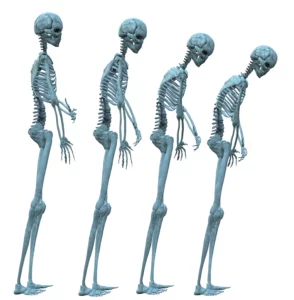Fractures of the spine are the most common, yet many people dismiss back pain as just a sign of getting older and don’t get the proper diagnosis. The reported incidence of hip fracture was 176 per 100 000 in White, 147.7 per 100 000 in Indian, and 43.5 per 100 000 in Black women between 2017-2018.3,4

Hip fractures are associated with a high risk of mortality. Faruk et al recently showed that in South Africa, one in three patients dies following a hip fracture. This is due to significant delays and barriers to surgery.5
A doubling of fracture rates in South Africa is predicted over the next two decades. Paruk et al stress that there is a dire need to prioritise hip fracture care in South Africa.1,5
Potential predictors of fracture
Post-menopausal women are particularly susceptible to osteoporosis and its severe sequelae. Long et al performed a meta-analysis aiming to identify potential predictors of osteoporotic fractures in postmenopausal women, with the goal of identifying high-risk patients and exploring potential therapeutic approaches.6
Their analysis included 10 studies (n=1 287 021) post-menopausal women. They found that age, body mass index, education (senior high school and above), parity (≥3), history of hypertension, diabetes, and alcohol intake, as well as age at menarche (≥15-years), age at menopause (<40-years), age at menopause (>50-years), oestrogen use, and vitamin D supplements were significantly associated with an osteoporotic fracture in post-menopausal women.6
They concluded that focusing on preventive strategies and identifying high-risk individuals, can reduce the burden of osteoporosis-related fractures in this vulnerable population.6
Bisphosphonates as first-line defense
Bisphosphonates are generally considered the first line of defense against osteoporosis. They function by inhibiting the activity of osteoclasts, cells responsible for bone resorption, thereby reducing bone turnover, increasing bone mineral density (BMD), and potentially lowering the risk of fractures in patients living with osteoporosis.7
Imam et al examined the effectiveness of bisphosphonates, particularly in post-menopausal women, in preventing future fractures based on clinical evidence. Their review included eight studies.7
A study involving 529 post-menopausal women found that those receiving bisphosphonate treatment had a significantly lower fracture incidence compared to the control group (2.89% vs 8.99%).7
In another study, researchers assessed the prevalence of new vertebral fractures in 7736 post-menopausal women and observed a substantial reduction in fractures in the treatment group compared to the control group (0.7% vs. 10.4%).7
Additional studies explored changes in BMD as a measure of bisphosphonate effectiveness. One study demonstrated significant increases in BMD in both the hip and spine of patients receiving bisphosphonate treatment compared to the placebo group.7
Studies also found a substantial difference in vertebral BMD between treatment and placebo groups, and significant increases in BMD at various body areas in the treatment group, whereas no such increases were observed in the placebo group.7
Adami et al showed that alendronate sodium led to significant improvements in bone mineral density at different doses, while Grey et al and Popp et al both reported significant increases in BMD, particularly in the spine and hips, in their respective studies. These findings collectively support the positive effects of bisphosphonates on bone density.8,9,10
Imam et al caution that it is essential to consider potential side effects and adverse events associated with bisphosphonate therapy. Osaki et al noted adverse events in both treatment and control groups, including gastrointestinal disorders in the treatment group and hip fractures in the control group.11
Greenspan et al reported a high incidence of adverse events in their trial, but no statistically significant differences were observed between the treatment and placebo groups. Grey et al mentioned iritis as a side effect in one participant in the treatment group.8,12
While these studies do highlight side effects, they do not necessarily suggest a major safety concern with bisphosphonate therapy, state Imam et al. In conclusion, bisphosphonates appear to be effective in reducing fracture risk and increasing bone mineral density, especially in post-menopausal women with osteoporosis.7
References
- Ward KA, Pearse CM, Madanhire T, et al.Disparities in the Prevalence of Osteoporosis and Osteopenia in Men and Women Living in Sub-Saharan Africa, the UK, and the USA. Curr Osteoporos Rep, 2023.
- National Osteoporosis Foundation of South Africa. [Internet] Available at: https://osteoporosis.org.za/
- What is osteoporosis? [Internet]. Available at: https://www.osteoporosis.foundation/patients/about-osteoporosis
- Dela SS, Paruk F, Brown SL, Lukhele M, et al. Ethnic and gender-specific incidence rates for hip fractures in South Africa: A multi-centre study. Bone, 2020.
- Paruk F, Matthews G, Gregson CL, et al.Hip fractures in South Africa: mortality outcomes over 12 months post-fracture. Arch Osteoporos, 2020.
- Imam B, Aziz K, Khan M, et al. Role of Bisphosphonates in Postmenopausal Women with Osteoporosis to Prevent Future Fractures: A Literature Review. Cureus, 2019.
- Adami S, Baroni MC, Broggini M, et al. Treatment of postmenopausal osteoporosis with continuous daily oral alendronate in comparison with either placebo or intranasal salmon calcitonin. Osteoporosis Int, 1993.
- Grey A, Bolland M, Mihov B, et al.Duration of antiresorptive effects of low-dose zoledronate in osteopenic postmenopausal women: a randomized, placebo-controlled trial. J Bone Miner Res, 2014.
- Popp AW, Guler S, Lamy O, et al.Effects of zoledronate versus placebo on spine bone mineral density and microarchitecture assessed by the trabecular bone score in postmenopausal women with osteoporosis: A three-year study. J Bone Miner Res, 2013.
- Osaki M, Tatsuki K, Hashikawa T, et al.Beneficial effect of risedronate for preventing recurrent hip fracture in the elderly Japanese women. Osteoporos Int,
- Greenspan SL, Perera S, Ferchak MA, et al.Efficacy and safety of single-dose zoledronic acid for osteoporosis in frail elderly women: A randomized clinical trial. JAMA Intern Med, 2015.




